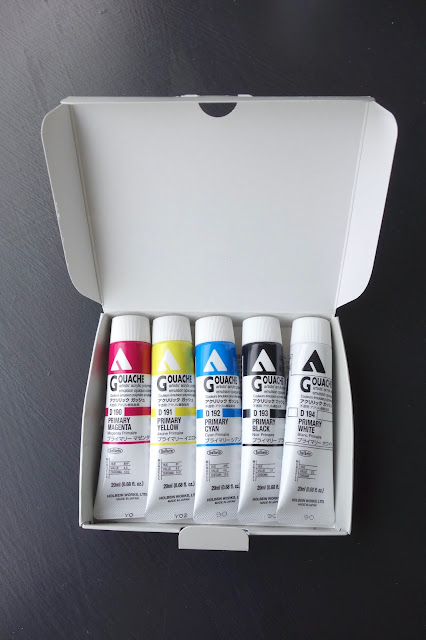A New Year means new skills to learn!
I stumbled upon the work of Emma Block on Instagram and I've been a fan of her work ever since. She creates whimsical illustrations with watercolor and gouache. Goo-what? Gouache is pronounced "gwash" or "goo-ash" and some describe it as opaque watercolors. Ever since I heard about gouache, I kept seeing different artists using it and the desire to try gouache kept growing inside me.
It just so happened that Emma Block came out with a book entitled "Get Started with Gouache." I borrowed a copy from the library and this is where my gouache journey began.
I bought this primary set of Holbein Acryla. I chose this brand because most illustrators use it so I'm taking a cue from the experts. Emma uses Designer Gouache from Windsor & Newton, and likewise recommends Holbein, Royal Talens, Caran D' Ache, and Schmincke. There are two kinds: (1) acrylic gouache has the matte finish of gouache but the waterproof permanency of acrylic and, (2) traditional gouache which is water soluble. So if you want to layer colors and make each shade distinct, acrylic gouache will work better.
Solid gouache is available but she doesn't recommend it because it doesn't give the thick consistency she's after.
The first step is to mix colors and make a test swatch (gouache dries darker on paper). Always start with a test swatch and wait for it to dry (adjust accordingly) before painting your final piece. Write down the colors you mixed to help you remember.
Add water gradually (water will make the paint thinner, more translucent and causes it to dry less evenly). The paint has to feel creamy in texture but is not thin and runny. Mix the paint well to avoid streaky results.
A tip to remember: Always replace the cap on the tube after squeezing out the paint. If the paint inside the tube is looking dry, dip the end of the exposed paint in clean water and put the cap back on.
I practiced using the exercises in the book:
Gouache dries quickly and with a flat, matte finish. Emma suggests combining it with colored pencils, watercolors, collage, and India ink for more character and depth.
I'm very used to watercolors where strokes are light and delicate. Painting with gouache needed a different approach: more heavy-handed to get an even, solid color. Mixing paint is also something I need to work on (I've been spoiled by watercolor pans). But as with all skills, I'll keep practicing!
Apart from this book, I found insightful tutorials here:
I love what Emma says about developing your style:
"People often worry about finding their artistic style. I always think everybody's style is like their handwriting, it's intrinsic to them. Everybody's artwork will have a unique quality due to their brushstrokes and line work. I don't think it's a good idea to try to choose a style that you think is on trend and produce work like that. It's important that your style feels natural to you and reflects the way you see the world. Don't worry about trying to find your style as quickly as possible; just enjoy the process and create as much work as possible. Also, don't worry if your style is changing. That's completely natural. It will continually evolve as you are inspired by new things, new materials, and become more confident in your drawing and painting abilities. The number-one piece of advice I can give anyone is to just keep painting. Don't worry about making mistakes, just keep going and have fun." - Emma Block, illustrator and author of "Get Started with Gouche"
Have you tried your hand at gouache? I would appreciate it if you send me some tips so my technique will turn from "blah to TADA!"
If you want "blah to TADA!" blog posts delivered to your inbox every week, please subscribe here.











How fun! I like what Ms. Block has to say about taking your time to find your painting style. I think that applies to writing, too. I've had to be patient. Good post, Claire!
ReplyDeleteSo true! Take your time to find your style. Thanks Priscilla!
Delete